There is also the problem with the neighbors. By law, tenants in apartment buildings have the right to make music every day. Courts have confirmed, among other things, that neighbors can be expected to play the violin for 3 hours [sic!!!]. However, this does not apply to particularly “loud instruments”. According to the doctrine, percussion and trumpet are regarded as such. This probably also includes alphorns (the Supreme Court has not yet made a definitive statement on this). So if you play the alphorn in your rented apartment, you’re in trouble.
Box: What does “loud” mean?
Musical instruments emit air pressure vibrations. The amplitude of these vibrations (the upward and downward deflection of the sound wave) determines the sound pressure and thus the perceived volume. The sound pressure level can be measured objectively in decibels (dB). We perceive a 10 dB increase in the sound level as a doubling of the volume.
In a quiet room, we are exposed to a sound pressure level of around 20-30 dB. If a television is running at room volume or a normal conversation is taking place, the sound pressure level rises to around 50-60 dB. On the dance floor of a discotheque at 100 dB. Sound pressure levels above 85 dB are unhealthy in the long term; short-term exposure above 120 dB can cause hearing damage.
The measured sound pressure of a musical instrument depends on the measuring distance. Usually 3m; most instruments (horn, saxophone, flute, violin) reach 95-97 dB from this distance. Trumpet and trombone (around 105 dB; similar to alphorn and Büchel) and percussion (>110 dB) are louder. If the distance to the sound source is halved, the measured sound pressure level increases by around 6 dB. In closed rooms, the volume and sound are also significantly influenced by the reflection of sound waves. In the case of the alphorn, sound waves are not only emitted from the cup, but the tube also transmits vibrations to the surrounding air.
The second best solution (after a soundproof practice room or playing outdoors) is to use mutes. There are different models on the market. The question of which one is the best is often asked in facebook groups. To answer this once and for all objectively, I have “scientifically” compared four well-known alphorn mutes – a standard design modified for alphorn, the Yamaha Silent Brass system, the Odi / Bader box and the eco-silencer from Kurt Ott. I made recordings and sound measurements on site with and without mutes. For the recordings I used a cardioid microphone 1m in front of the bell and a stereo microphone about 2m next to the horn for the surround sound. I also used a sound measurement app on my cell phone. Since every mute influences the intonation, I measured the effect from C2 all the way up to C6. And I have recorded my subjective impressions regarding blowing resistance and response. Here are my conclusions.
Mute by resunar
Stephan Kost has developed a special mute for alphorns and has it produced in small series under his brand resunar. The design corresponds to similar products for brass players, but is adapted to the shape of the alphorn bell. Visually, the mute resembles an urn with a hole in the bottom; it is surprisingly thin-walled and light. Six different sizes are listed on the resunar website at a price of CHF 248. Stephan has already sold around 200 of these silencers.
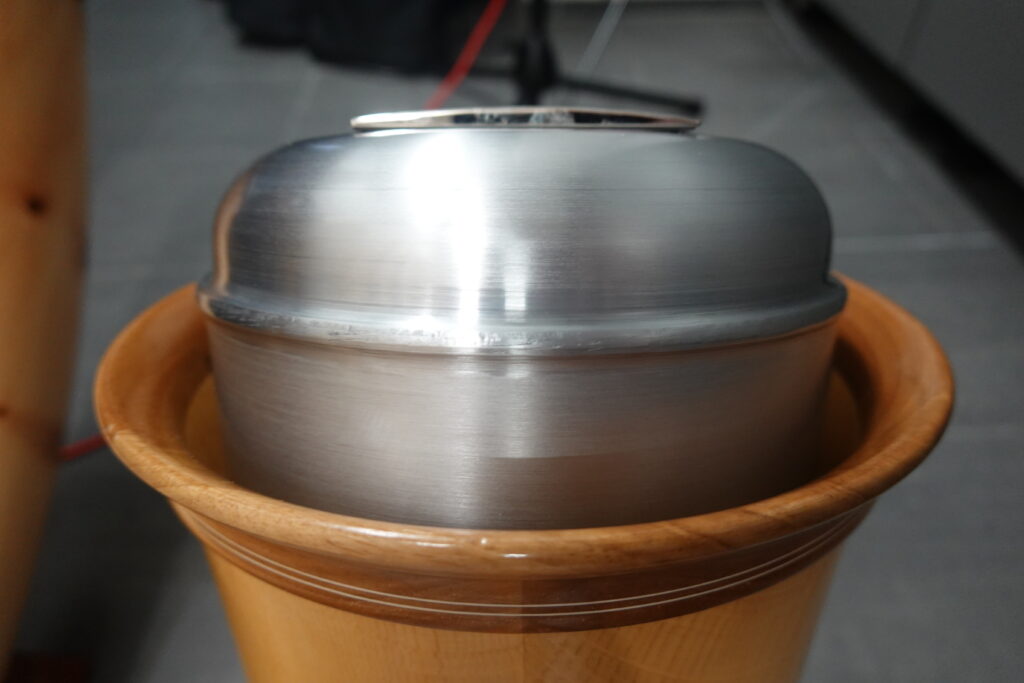
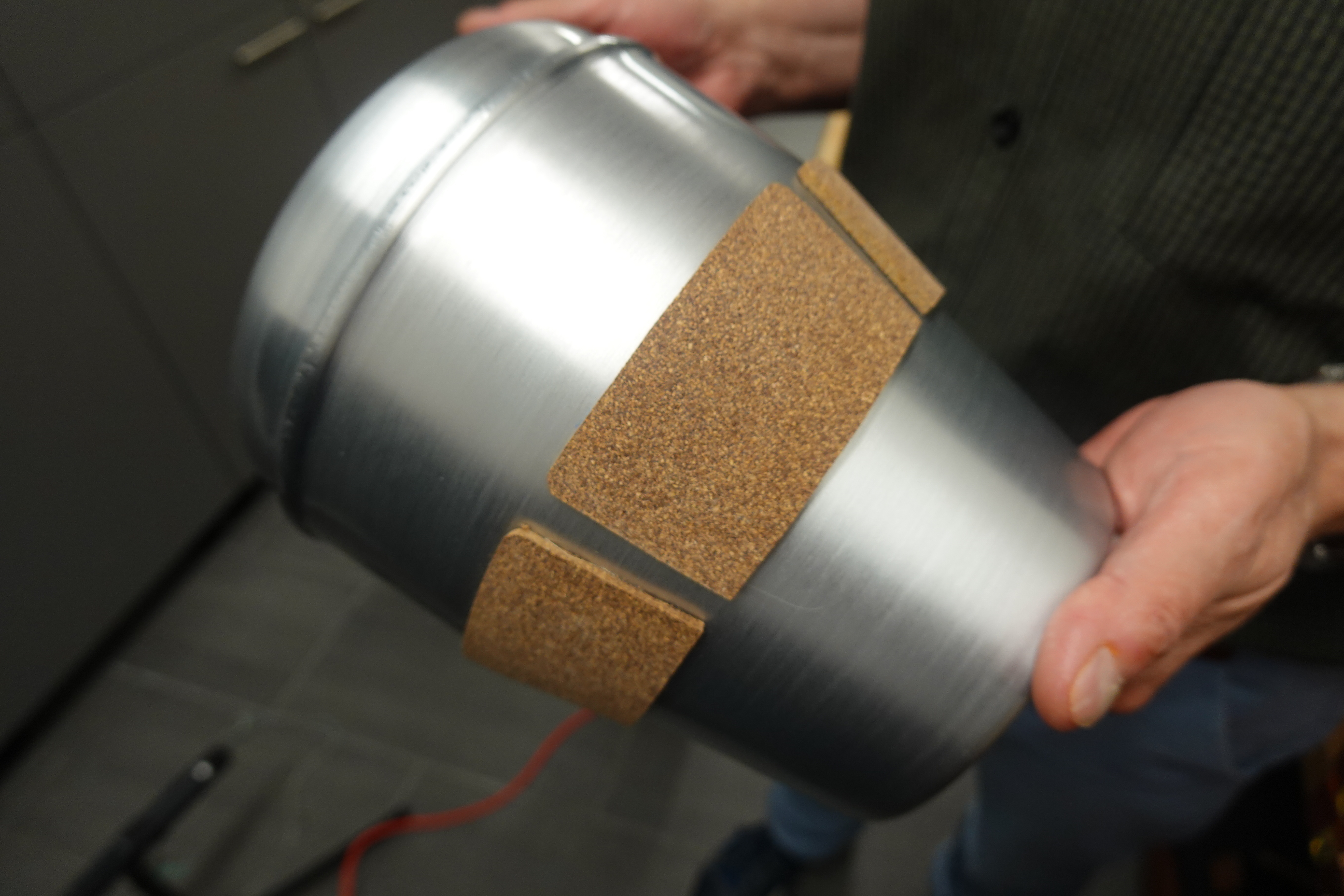
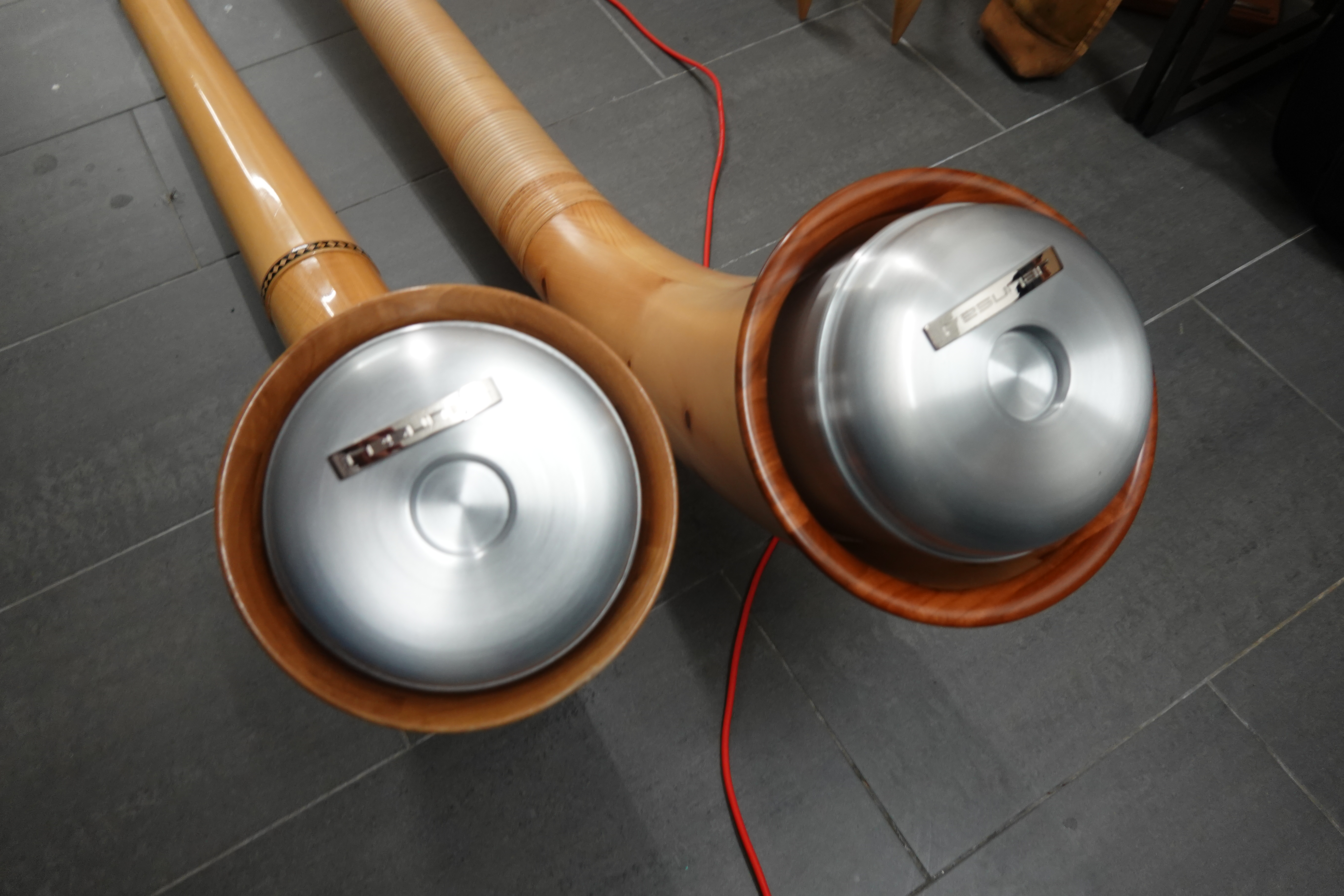
The silencer does what it was designed to do. The reduction in sound pressure is good. While I observed a reduction of just under 10dB on the cell phone with the music stand, the recordings in front of the bell showed a dampening of 22dB and the room microphone around 14dB.
Playing with the mute remained pleasant. The back pressure increases slightly. Nevertheless, the dynamics are linear and the response remains good. The intonation from C4 upwards is little affected compared to playing without mute. In the lower tones I measured a distortion of around 24-28 Cts – this is clearly audible.
In addition to volume and intonation, the sound is influenced by the mute. Trumpets and trombones deliberately use similar models as an effect. What is particularly noticeable here is that the overtones are greatly reduced. The sound loses its brilliance due to the mute and becomes muffled. The spectrogram below shows how the overtones above 1.5kHz are cut off (gray without attenuator, red with attenuator).
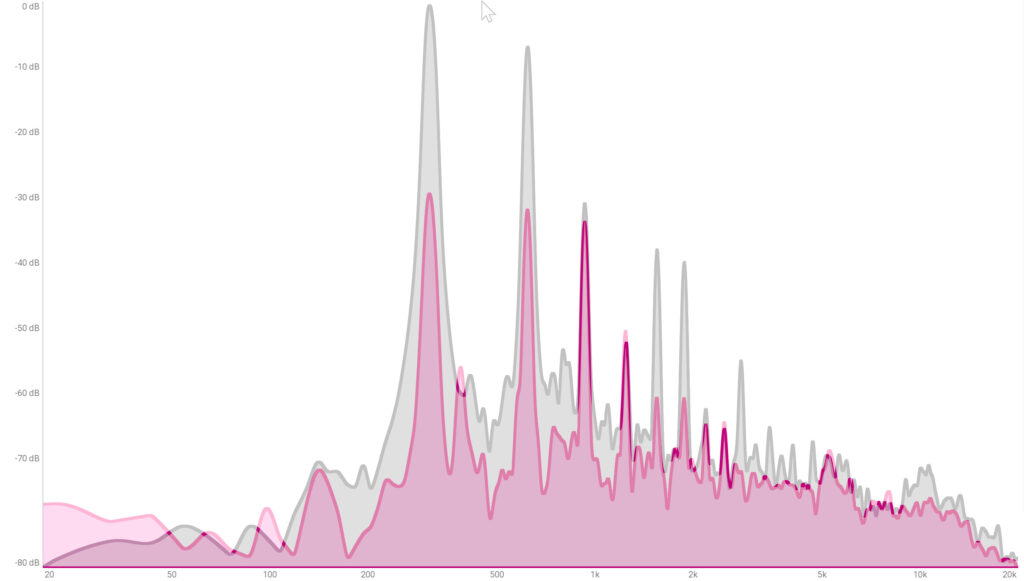
All in all, a simple solution suitable for everyday use. Good damping, acceptable compromises in feel. The shock absorber takes up little space in the suitcase – the cavity can be filled with soft laundry, for example, when packing.
Yamaha Silent Brass
The Yamaha Silent Brass System is more than just a simple mute. The sound in the bell is recorded by an integrated microphone, processed in a small box (the “Personal Studio”) and then played back via headphones. Yamaha uses a technology called “Brass Resonance Modeling” – frequencies are electronically remixed and resonance is added to compensate for the typical closed mute sound.
Musik Grimm in Winterthur carries a version adapted for the alphorn. It is based on the euphonium mute. A foam rubber seal is neatly glued on top, which fits perfectly into the alphorn bell. The retail price of CHF 555 for the customized complete system is around CHF 200 more than the original model – in my opinion a fair surcharge for the effort and the well thought-out solution. DIY enthusiasts can save a few francs.
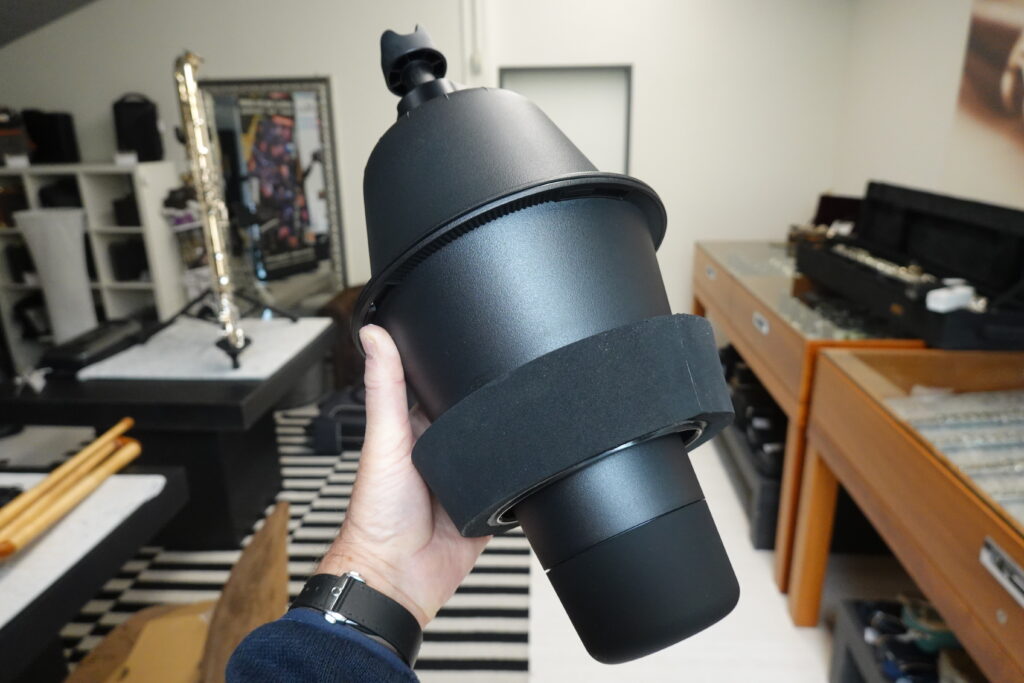
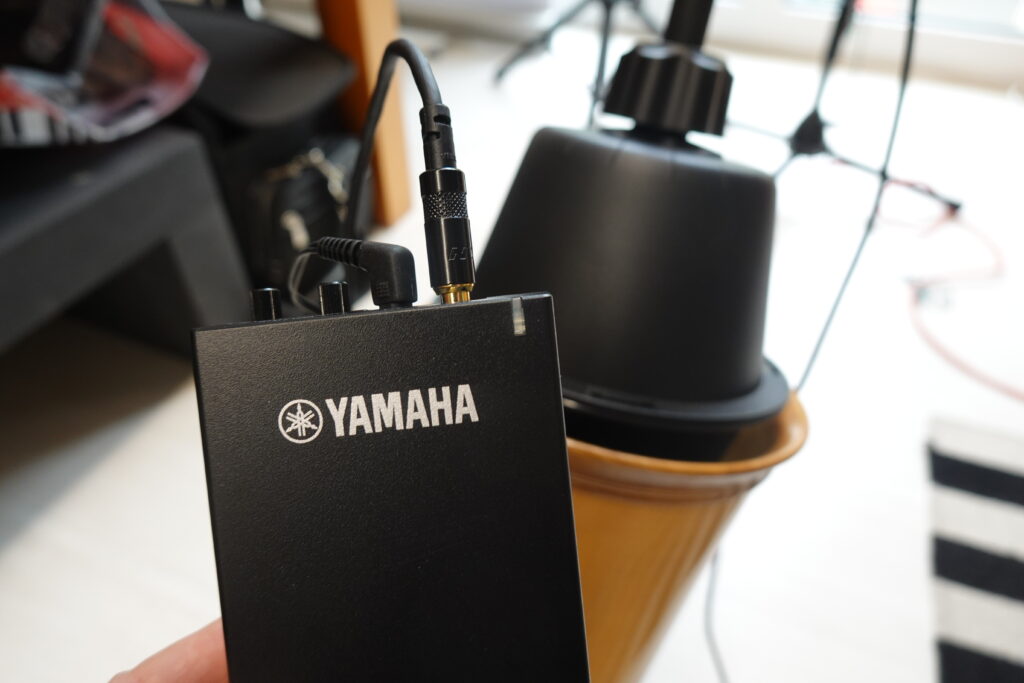

In the test, the effective sound attenuation in front of the bell is noticeable; in fortissimo I was able to measure a reduction in sound pressure of up to 28db. The dynamics do not develop in a completely linear fashion; somewhere in the mezzo forte, the sound suddenly accelerates. In the room microphones, the attenuation was still around 15-20db; the cell phone at music stand distance shows a reduction of 12-14db.
The playing feel is only slightly restricted. The response remains surprisingly good despite the strong damping, even the quiet notes come across without any problems. The intonation problems are similar to those of the resunar mute – somewhat more pronounced. While the notes above C4 intonate more or less cleanly, they are distorted by up to a semitone below. The resulting intervals take some getting used to.
The modeling of the alphorn sound is quite impressive on the headphones. There is a boom in the bass range. When listening in isolation at home, the sound remains somewhat tubby – this is probably due to the fact that the Brass Resonance Modelling has not been optimized for alphorns. At least you can increase the room effect on the Personal Studio and thus achieve a somewhat broader playing feel.
All in all, a premium solution with strong sound absorption. The detour via the electronic box also offers the option of recording yourself and recording play-alongs via the aux input. The distortion of the intonation is particularly noticeable in the bass.
Eco-mute by Swiss-Alphorn
Kurt Ott has been bothered by the intonation problems of conventional mutes and sells an eco-silencer made of seaweed as the result of his long tinkering. It resembles a flower pot that protrudes only slightly into the bell. The damping can be adjusted using cork disks. Kurt is selling his mute on Swiss-Alphorn.ch at a price of 68 CHF.

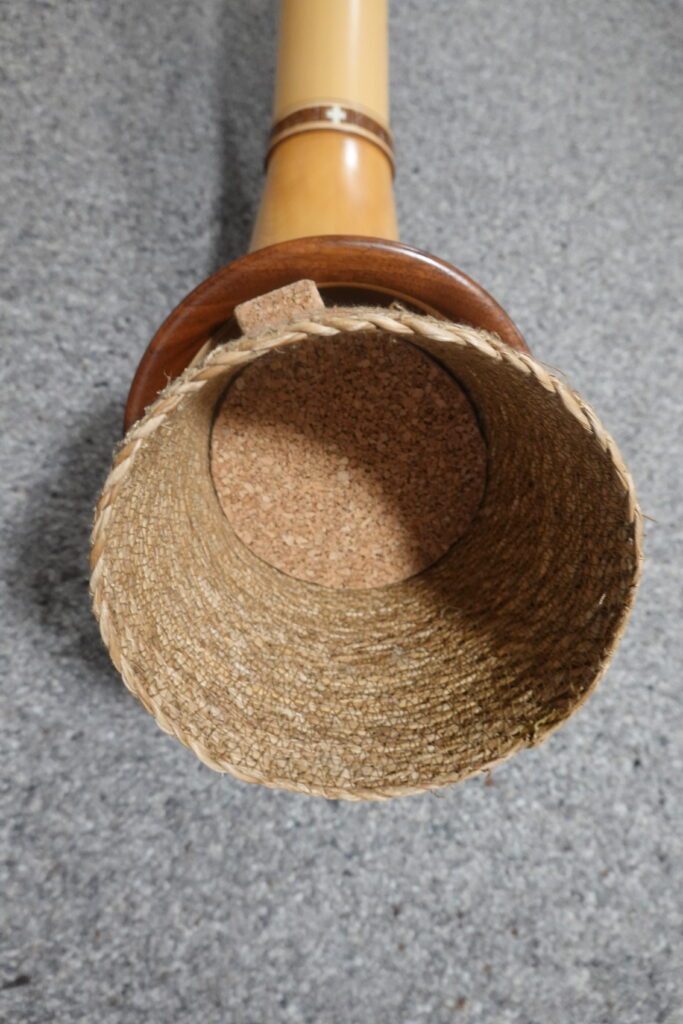
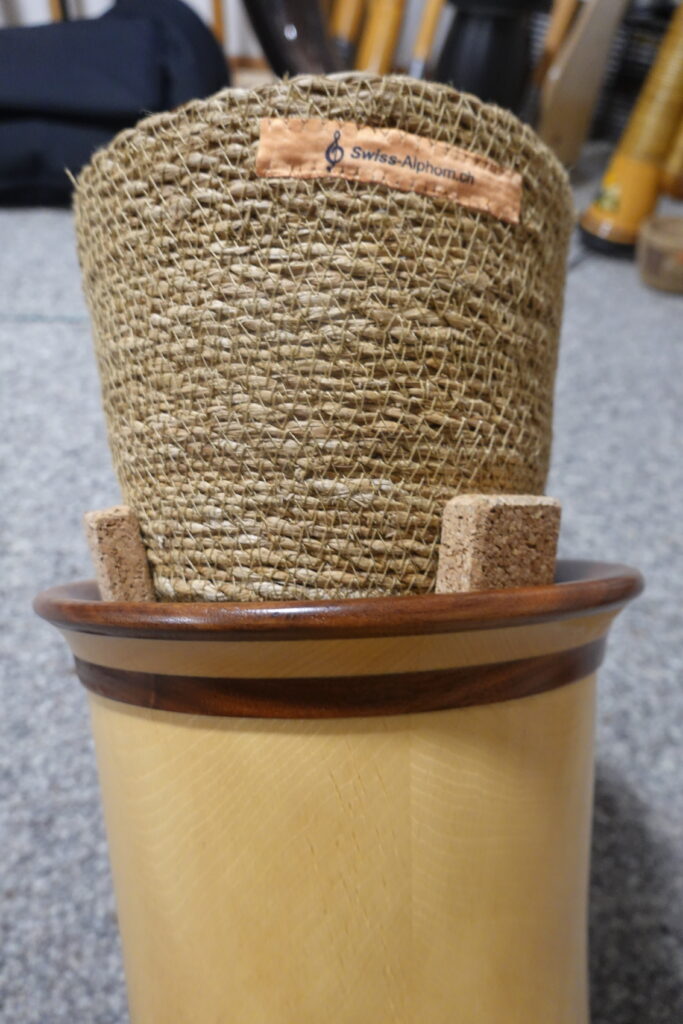
The eco mute can’t quite keep up with the other models in terms of attenuation: Just under 10dB in front of the cup, 8dB on the room microphone, 6dB on the sound level app on the cell phone. Subjectively, we had the impression on site that certain “critical” frequencies were attenuated (close to the natural frequency of the practice room?). This impression was confirmed when analyzing the sound recording: especially the overtones between 500-1500Hz are reduced.
The feel of the eco silencer remains very good. The intonation is significantly less distorted than with the two models above. Response and dynamics are unproblematic.
I was only able to reproduce the expected effect of additional cork disks to a limited extent: While the measured sound level was reduced by perhaps 1dB per additional disc, the main changes were in the timbre and the subjective back pressure.
If the most effective damping is not important, the eco silencer is a “gentle” alternative: affordable, low intonation distortion and easy to take anywhere.
The box
The bell of the alphorn stands motionless on the ground. Instead of “plugging” the bell, you may want to put it into a soundproof box. Odi offers a corresponding box in his alphorn shop at a price of CHF 250. It is a clean, mass-produced construction made of plywood by Andreas Bader with additional sound absorption using pyramid foam. The alphorn protrudes into the box through a kind of archway.
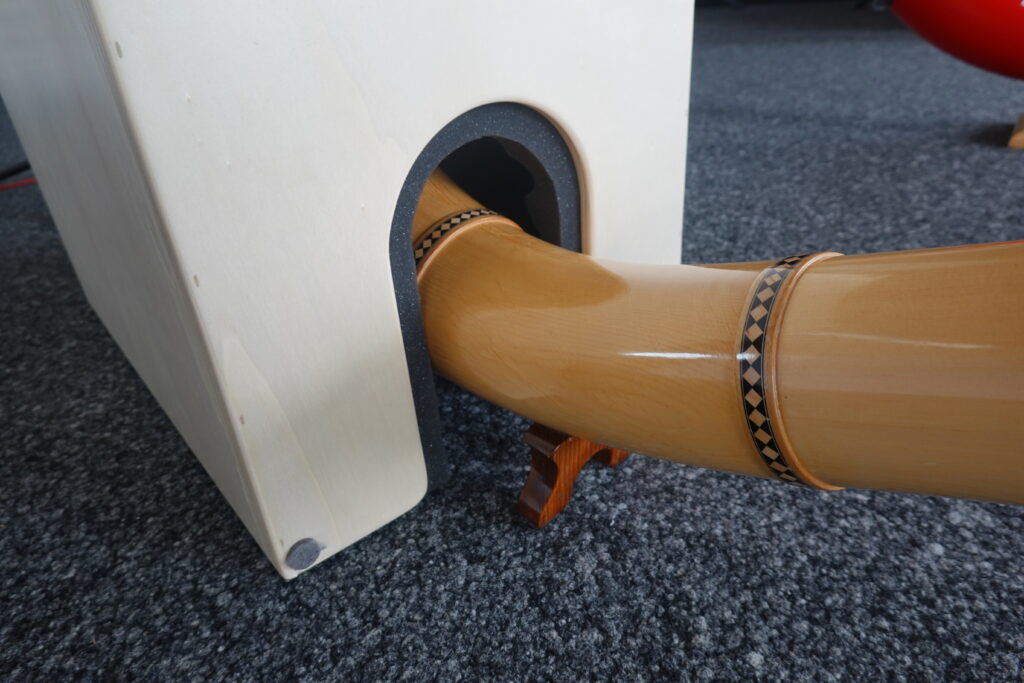
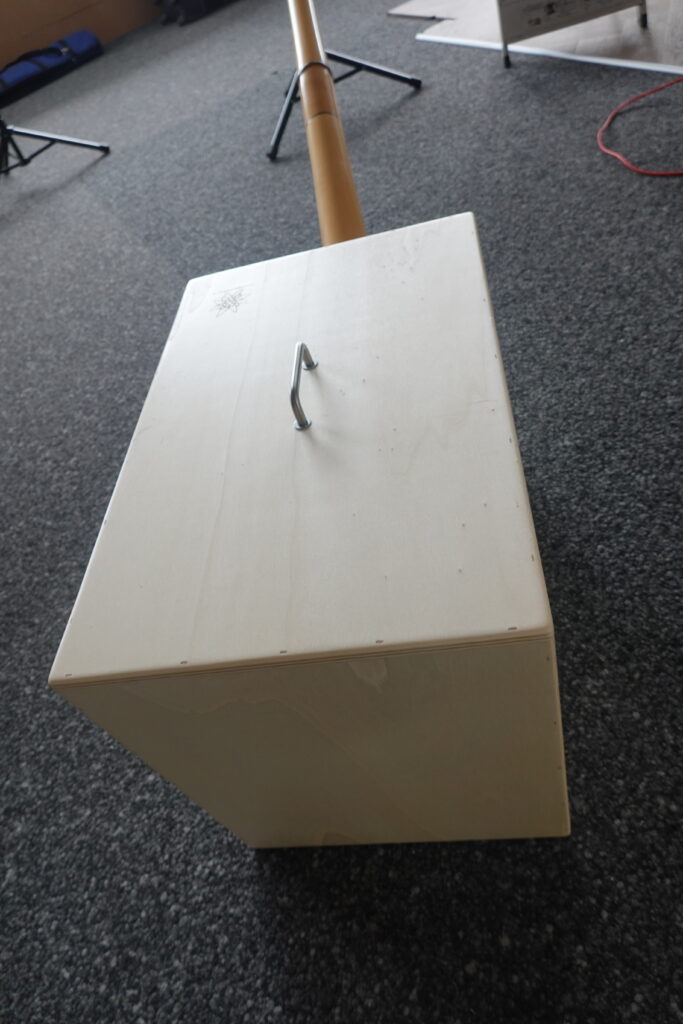
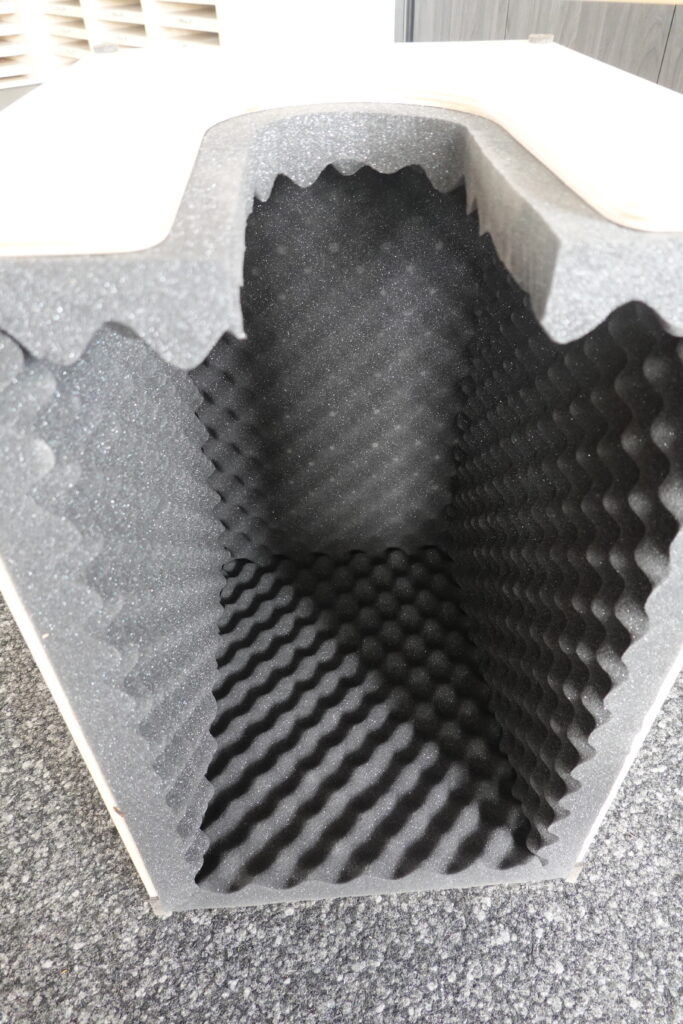
Compared to the previous mutes, the attenuation is in the medium range. In front of the bell, the level drops by about 18dB. In the room by about 15dB. The result depends heavily on how the bell is inserted. The configuration in the picture above leaves about 20 cm of free space before the sound hits the wall. With my Bärtschi horn, the foot is relatively far back and therefore the entrance remains open. I have also tried to plug the opening with a blanket – this provides an additional 6dB attenuation – but with a loss of feel.
In the “standard configuration”, playing feel and intonation are hardly affected. The response is practically unchanged and the dynamics can be easily varied. You can also practise in a duo, trio or larger groups.
All in all, a simple and effective solution. Anyone who doesn’t mind the bulky and immobile box in the living room will be happy with it. And of course, resourceful DIY enthusiasts can build their own cardboard boxes and dog kennels.
Conclusion
The mutes tested here reduce the sound pressure directly in front of the cup by around 10-30 dB and in the room by around 8-15 dB. This makes the “loud instrument” alphorn comparable to a piano. The silencer legalizes practicing in the rented apartment – purpose fulfilled! However, this only applies outside the statutory rest period – the remaining noise level of 65-85 dB still exceeds “room volume”. Whether the alphorn disturbs the neighbors also depends on other factors: the level of playing, the folklore compatibility of the neighbors, the construction quality of the partition walls. Depending on the situation, every additional decibel is relevant for the neighborhood.
I was unable to find a clear winner among the four models tested. The model from resunar corresponds to the “typical” mute and plays (except in the lowest register) without too many compromises. The Yamaha system is more expensive and heavier, damps a little better and offers added value for play-alongs. Kurt Ott’s eco silencer is a more economical solution with weaker damping and less distortion of the intonation. Odi’s box gives the best playing feel and the smallest distortion of the intonation; however, not everyone wants such a piece of furniture in their living room.
What is also clear is that all mutes are auxiliary solutions. The alphorn sounds duller/roarier everywhere. You can’t really work on the sound this way (but you can work on embouchure, stamina, accuracy, interpretation, agogic…). If you practise exclusively with the mute, you will have to get used to the instrument every time you play freely. But all this is better than not practicing at all.
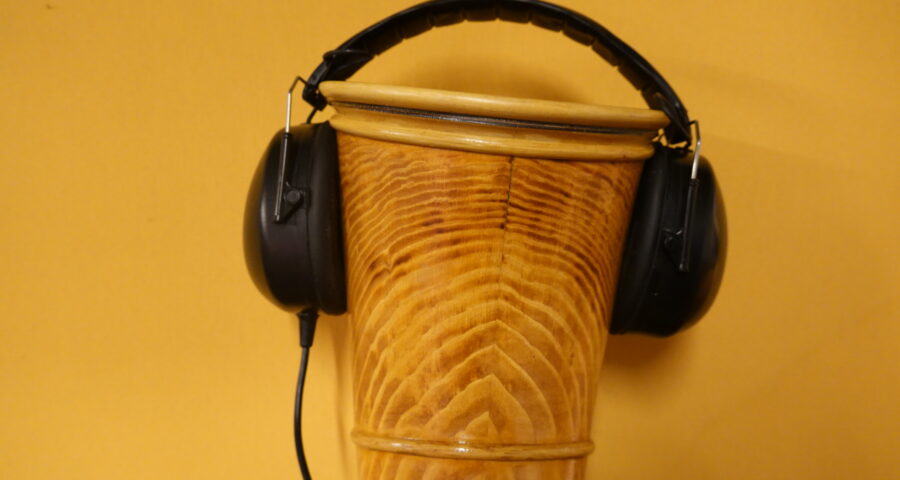
Leave a Reply